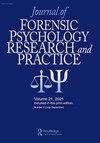An Item-Level Examination of a Youth Assessment: Practical Implications of Alternate Measurement and Analytic Procedures
IF 1.1
4区 心理学
Q4 CRIMINOLOGY & PENOLOGY
Journal of Forensic Psychology Research and Practice
Pub Date : 2022-02-14
DOI:10.1080/24732850.2022.2026856
引用次数: 0
Abstract
ABSTRACT To date, research has focused on the scale-level properties of juvenile risk assessments, such as their predictive validity across populations. Although these studies are valuable, they provide little item-level information to inform future developments in assessment strategies. Item-level information, including the difficulty and discrimination parameters of the items that comprise the scale, provides insight into patterns of endorsement across risk levels. The current study examines the item-level characteristics of the Ohio Youth Assessment System-Disposition Tool (OYAS-DIS) in a sample of 459 justice-involved youths across a Midwestern state. Using the two-parameter logistic model of Item Response Theory, discrimination and difficulty parameters were estimated for each item that comprises the OYAS-DIS. A test information curve was also examined to determine the levels at which the OYAS-DIS provides the most information. Results indicated that prosocial decision-making items had low difficulty, meaning that even low-risk youths endorsed them. Overall, OYAS-DIS provides the most information for low- to high-risk youths, but additional items should be created to examine prosocial decision-making, as these items may be characteristic of justice-involved youths as a group and not an indicator of greater recidivism risk.青年评估的项目水平检查:替代测量和分析程序的实际意义
迄今为止,研究主要集中在青少年风险评估的尺度水平属性,如其在人群中的预测效度。虽然这些研究很有价值,但它们提供的项目一级信息很少,无法为今后评价战略的发展提供信息。项目级信息,包括构成量表的项目的难度和辨别参数,提供了对跨风险级别背书模式的洞察。目前的研究考察了俄亥俄州青年评估系统-处理工具(OYAS-DIS)的项目水平特征,在一个中西部州的459个司法参与青年的样本中。利用项目反应理论的双参数logistic模型,估计了构成oias - dis的每个项目的辨别度和难度参数。还检查了测试信息曲线,以确定oyaas - dis提供最多信息的水平。结果表明,亲社会决策项目的难度较低,即低风险青少年也支持这些决策项目。总体而言,oias - dis为低至高风险青少年提供了最多的信息,但应该增加一些项目来检查亲社会决策,因为这些项目可能是参与司法的青少年作为一个群体的特征,而不是更大的再犯风险的指标。
本文章由计算机程序翻译,如有差异,请以英文原文为准。
求助全文
约1分钟内获得全文
求助全文
来源期刊
CiteScore
1.80
自引率
12.50%
发文量
53

 求助内容:
求助内容: 应助结果提醒方式:
应助结果提醒方式:


